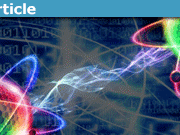How the EPR Paradox Fits Between Entanglement and Nonlocality
If we violate a Bell inequality, we know we have quantum entanglement, and it used to be thought that these two notions were one and the same.
At least, this was commonly accepted until 1989, when R.F. Werner actually proved that this isn’t so. There really are some entangled states that are Bell-local — states that you can always describe with a Local Hidden Variable (LHV) Model, and which therefore will never violate any Bell inequality.
Since then, physicists have shown that Bell-nonlocality is formally stronger than entanglement as far as correlations go. If the correlations between positions [itex]x_A[/itex] and [itex]x_B[/itex] of particles [itex]A[/itex] and [itex]B[/itex] can be explained by an LHV model, then their joint probability distribution [itex]\rho(x_A,x_B)[/itex] factors when you condition on these hidden variables [itex]\lambda[/itex] (as seen in the following equation).
[itex]\rho_{LHV}(x_A,x_B)=\int d\lambda \;\rho(\lambda)\; \rho(x_A|\lambda) \;\rho(x_B|\lambda).[/itex]
Bell inequalities are mathematical consequences of LHV models like this, which is why violating Bell inequalities rules out such LHV models.
If you add the extra assumptions that the probabilities [itex]\rho(x_A|\lambda)[/itex] and [itex]\rho(x_B|\lambda)[/itex] have to be described quantum-mechanically (i.e., as arising from some wavefunction or density matrix), then what you have is a model for a separable (i.e., not entangled) state:
[itex]\rho_{sep}(x_A,x_B)=\int d\lambda \rho(\lambda) \; Tr[\hat{\rho}_{\lambda}^{A}|x_{A}\rangle\langle x_{A}|] \; Tr[\hat{\rho}_{\lambda}^{B}|x_{B}\rangle\langle x_{B}|].[/itex]
So all separable states’ statistics can be described by some LHV model, but not all states whose statistics obey an LHV model are separable. This extra assumption of quantum mechanical origins of probabilities limits the possible probabilities in a big way because our statistics have to obey the uncertainty principle.
So here we have a relatively tidy picture of the difference between entanglement and Bell-nonlocality. The correlations inseparable states obey a special kind of LHV model, where the statistics of both particles [itex]A[/itex] and [itex]B[/itex] also have to be quantum-mechanical in origin.
More recently though, people have been considering the intermediate case.
What if we say that only the statistics of particle [itex]B[/itex] have to be described quantum mechanically? i.e.,
[itex]\rho_{LHS-B}(x_A,x_B)=\int d\lambda \rho(\lambda) \;\rho(x_A|\lambda)\;Tr[\hat{\rho}_{\lambda}^{B}|x_{B}\rangle\langle x_{B}|].[/itex]
What we get by ruling out such intermediate models is a level of correlation that’s definitely stronger than entanglement, but definitely weaker than Bell-nonlocality. This level of correlation is called EPR-steering and is synonymous with demonstrating the EPR-paradox. Inequalities derived from these sorts of LHV models (called Local Hidden State (LHS) models for [itex]B[/itex]) are called EPR-steering inequalities, which when violated, also demonstrate the EPR-paradox. Since here, the statistics of [itex]B[/itex] must be quantum mechanical in origin, all statistics of [itex]B[/itex] obey the uncertainty principle, even when conditioning on other variables.
Now, we have something of a hierarchy of correlation, where separable states, are a subset of non-steerable (we could all them EPR-local) states, which are in turn a subset of states obeying some sort of LHV model (we could call them Bell-Local). But what does EPR-steering have to do with the EPR paradox?
EPR-steering is a relatively new concept in quantum physics having only just been formalized in 2007 (and which doesn’t even have a Wikipedia article yet). That being said, the fundamental ideas behind EPR-steering date back to the days following the original EPR-paradox paper in 1935. In Schrodinger’s response to the EPR-paradox paper, he remarks that it is rather uncomfortable that the theory (of quantum mechanics) allows the state (of a particle) to be steered at the experimenter’s mercy in spite of their having no access to it. What this “steering” is, is best explained by looking back at a simplified version of the EPR-paradox.
Consider two particles [itex]A[/itex] and [itex]B[/itex], described by a single joint wavefunction highly entangled in position and momentum. We separate them by a long distance so that light cannot travel between them in the time we make our measurements. They are so highly correlated that measuring the position of [itex]A[/itex], allows you to predict the position of [itex]B[/itex] with near certainty, and the same goes for momentum. If we live in a local universe, then everything there is to know about the statistics of [itex]B[/itex] is within the past light cone of [itex]B[/itex] (i.e,. the set of all points in the past where light or slower things could conceivably affect [itex]B[/itex] at the time of measurement). Since particle [itex]A[/itex] is outside [itex]B[/itex]’s past light cone, its statistics couldn’t possibly tell you more about [itex]B[/itex] than knowing everything in [itex]B[/itex]’s past light cone. In addition, all this knowledge of the history of [itex]B[/itex] cannot reduce your measurement uncertainty by more than what the uncertainty principle allows. Because of this, if we condition our measurement results of [itex]B[/itex] on the results of [itex]A[/itex], we should not be able to get conditional uncertainties beyond the limits of the uncertainty principle. However, there’s no limit to how strong the correlations between [itex]A[/itex] and [itex]B[/itex] can actually be, and we can have both conditional position and conditional momentum uncertainties be arbitrarily small. The conditional uncertainty relations that can be violated by strong enough correlations are some of the first EPR-steering inequalities. The EPR “paradox” is that it seems that quantum physics can’t be a complete description of reality if the universe is also local. These are mutually exclusive.
As far as why it’s called “steering”, quantum mechanics tells us that in the EPR scenario if you measure the position of [itex]A[/itex], the quantum state of [itex]B[/itex] will be one of well-defined position. If you measure the momentum of [itex]A[/itex], then [itex]B[/itex] will be in a state of well-defined momentum. By choosing whether to measure the position or momentum of [itex]A[/itex], one has influence over the ensemble of states of [itex]B[/itex], though this influence can only be realized with the additional information about the outcome of the measurement. This phenomenon is known as quantum steering since one can “steer” the ensemble of states of [itex]B[/itex] by manipulating [itex]A[/itex] (and this is the “steering” Schrodinger was talking about). However, quantum steering is not sufficient to enable faster than light signaling because the density matrix of [itex]B[/itex] is totally independent of manipulations of [itex]A[/itex] unless one also conditions on the measurement outcome of [itex]A[/itex], which would have to be communicated to [itex]B[/itex] by conventional means.
So how does the EPR paradox fit between entanglement and nonlocality? Right in the middle. The sets of Bell-Local, EPR-local, and separable states form concentric sets in a hierarchy of correlation, and research into applications of these correlations is a rapidly growing field with significant results coming out every month.








[QUOTE=”Android Neox, post: 5479742, member: 543121″]I agree that there aren’t hidden variables, local or otherwise.
Within a universe model, how is the Bell inequality explained? How about the simpler case of an entangled pair of particles? Clearly, at the instant of observation the set of possibilities for future observations changes, for the observer. For example, observing that particle (A) of a pair has spin up would (in the right kind of experiment) guarantee that particle (B) could only be observed to have spin down. For the observer, as soon as the state of (A) is observed, the state of (B) is known. Simultaneity.
Unless all changes to reality are constrained by the speed of light, the theory is going to have serious problems. If it depends upon simultaneity (and I cannot see how to avoid this in a universe model) then it cannot be correct unless special relativity is entirely wrong (which is going to be an even more serious problem).[/QUOTE]
I don’t know, what you mean by “universe model”, but for the two particles or photons it’s clear. Say we have the usual singlet state for the polarizations of two photons ##|Psi rangle=(|HV rangle-|VH rangle)/sqrt{2}##. If now A measures that her photon is horizontally polarized, and then she knows immediately that B must find a vertically polarized photon, but B doesn’t know it instantaneously, but A must send him a message of her knowledge, for which she can only use signals which spread at most with the speed of light. If B doesn’t get this information from A he’ll just find a vertically polarized photon, but he cannot predict this. For him, the stream of photons in an ensemble of such prepared photons is still just a stream of unpolarized photons. Only exchanging the information on their measurements A and B can observe the 100% polarization correlations (when they measure the polarization in orthogonal directions; for arbitrary angles between the polarizers at A and B you get other statistics for the pairs of polarizations, including such that violate the Bell inequality based on local deterministic hidden-variable models). Thus, there’s no faster-than-light communication possible using entangled states.
[QUOTE=”Android Neox, post: 5479742, member: 543121″]Within a universe model, how is the Bell inequality explained?[/QUOTE]
By QM.
[QUOTE=”Android Neox, post: 5479742, member: 543121″]How about the simpler case of an entangled pair of particles? Clearly, at the instant of observation the set of possibilities for future observations changes, for the observer. For example, observing that particle (A) of a pair has spin up would (in the right kind of experiment) guarantee that particle (B) could only be observed to have spin down. For the observer, as soon as the state of (A) is observed, the state of (B) is known. Simultaneity.'[/QUOTE]
Put a red bit of paper in an envelope, a green bit of paper in another and send one to the other side of the universe. Open one and you know the contents of the other with all that is said above holding. Yet its not some deep deep mystery – but for some reason some want to make out EPR is. Its exactly the same – just a correlation. The key difference is QM is silent about the value of quantities until observed. The paper is red or green at all times. This crucial difference allows a correlation between objects with statistical properties different to the paper slips. That’s all EPR is – just a correlation with novel statistical properties. Its not some great deep mystery – QM explains those statistical properties easily so we know exactly whats going on. The issue is simply this – since QM is silent on the value of quantities before observation what if we insist they do have values. QM doesn’t say one way or the other. It turns out if you insist then you need FTL communication – but only if you insist. That is very very interesting, and would have rightly earned Bell a Nobel prize had he lived – but if FTL worries you simply don’t insist.
[QUOTE=”Android Neox, post: 5479742, member: 543121″]Unless all changes to reality are constrained by the speed of light, the theory is going to have serious problems. If it depends upon simultaneity (and I cannot see how to avoid this in a universe model) then it cannot be correct unless special relativity is entirely wrong (which is going to be an even more serious problem).[/QUOTE]
There is no issue with FTL or even instantaneous communication and relativity providing it cant be used to send information. The interesting thing about standard QM is its based on classical mechanics, and as Landau explains in his beautiful but terse textbook, right at its foundations it is non-local (it obeys the Galilean transformations – and so does ordinary QM):
[URL]http://www.amazon.com/Mechanics-Third-Course-Theoretical-Physics/dp/0750628960[/URL]
In fact you can see the dynamics QM developed from that assumption alone in Chapter 3 of Ballentine – but that is just bye the bye.
One needs to go to QFT to rectify that and the concept of locality there is rather more subtle:
[URL]https://www.physicsforums.com/threads/cluster-decomposition-in-qft.547574/[/URL]
One needs to exclude correlated systems, and bell states are correlated. This leaves the whole question of locality and EPR in a rather interesting position. One could argue, and I do, the question of locality doesn’t even apply. But that is a matter of interpretation and opinion.
Thanks
Bill
[QUOTE=”vanhees71, post: 5479269, member: 260864″]There is no action at a distance related to entangledment, …
… There is, however no action-at-a-distance (instantaneous) causal effect by measurement on partial system[/QUOTE]
I agree that there aren’t hidden variables, local or otherwise.
Within a universe model, how is the Bell inequality explained? How about the simpler case of an entangled pair of particles? Clearly, at the instant of observation the set of possibilities for future observations changes, for the observer. For example, observing that particle (A) of a pair has spin up would (in the right kind of experiment) guarantee that particle (B) could only be observed to have spin down. For the observer, as soon as the state of (A) is observed, the state of (B) is known. Simultaneity.
Unless all changes to reality are constrained by the speed of light, the theory is going to have serious problems. If it depends upon simultaneity (and I cannot see how to avoid this in a universe model) then it cannot be correct unless special relativity is entirely wrong (which is going to be an even more serious problem).
There is no action at a distance related to entangledment, but it’s described by states of systems that are not localized and thus observations of far-distant parts of the system can be correlated, but this correlation is due to the preparation of the state long before any measurement on the partial systems is done. The new aspect of quantum theory as compared to classical theory is that there can be 100% correlations of observables on partial systems that are utmost uncertain (undetermined), i.e., the quantum correlations described by entangled states, where observables of far-distant parts of the quantum system, are much stronger than allowed by any local-deterministic (hidden-variable) model. There is, however no action-at-a-distance (instantaneous) causal effect by measurement on partial system A on any far-distant measurement on partial system B. This is so by construction of relativistic quantum theory in term of local, microcausal quantum field theories (as is the Standard Model of elementary particles).
[QUOTE=”Jeronimus, post: 5478891, member: 439773″]Wouldn’t it be obvious that if there is action at a distance, it would be action at a spacetime-interval(distance) rather than just a space-interval(distance), as as you mentioned already, different observers moving at different velocities relative to each other would consider the two events to be happening at different times.
Only within one specific inertial frame would the events occur “at the same time”[/QUOTE]
The “action at a distance” interpretation of entanglement is that the act of observing the state of one member of an entangled pair [U]causes, in that instant[/U], the state of its partner to change from a multiplicity of all possible states to one particular state. Simultaneity. Without simultaneity, the argument doesn’t work.
But, 110 years of examining and testing of Special Relativity have proven (It’s the closest thing to established fact that I can think of.) non-simultaneity. That is, for every frame that sees two physically separated events as simultaneous, there is another equally valid frame for which one preceded the other and another equally valid frame from which the events occurred in reverse order. Non-simultaneity.
I think the only reasonable interpretation is not that observation alters the observed but that observation alters the observer. Do physicists think they are free of the constraints of physical law? If an observer were to observe a mismatch between the entangled particles, (s)he would enter a quantum state for which there would be no Hermitian eigenmatrix. Literally, the observer would enter an “unobservable” (Schrödinger’s term, but he probably said it in German) state.
There’s no reason to think every event acts backwards through time with the observations altering the observed. Delayed choice experimental results are not reversed time processes. Entanglement doesn’t require simultaneity. Just presume the math of QM is correct and remember the rules apply to everything in the universe. Observation alters the observer. Observation of anything inconsistent with the observer’s state would put the observer into an impossible state, and so inconsistencies (violations of conservation symmetries) are never observed. But, if every observer is “collapsing the wave function” for themselves, the only way to get an apparently seamless reality is a multiverse in which everything that can happen does happen.
Personally, I prefer causally-consistent models, even if they do require a multiverse.
[QUOTE=”Android Neox, post: 5478844, member: 543121″]Only non-local in a “universe” model, which is obviously inconsistent with QM. Only multiverse interpretations are consistent with QM and possible within known physics, e.g. non-simultaneity.
Action-at-a-distance [U]requires[/U] simultaneity and so is obviously not a correct interpretation of entanglement.[/QUOTE]
Wouldn’t it be obvious that if there is action at a distance, it would be action at a spacetime-interval(distance) rather than just a space-interval(distance), as as you mentioned already, different observers moving at different velocities relative to each other would consider the two events to be happening at different times.
Only within one specific inertial frame would the events occur “at the same time”
[QUOTE=”jfizzix, post: 5478834, member: 190322″]That being said, the only way for any agent to know that something nonlocal is going on is to have the data from both particles, which would have to be communicated to them at or below the speed of light.[/QUOTE]
Only non-local in a “universe” model, which is obviously inconsistent with QM. Only multiverse interpretations are consistent with QM and possible within known physics, e.g. non-simultaneity.
Action-at-a-distance [U]requires[/U] simultaneity and so is obviously not a correct interpretation of entanglement.
[QUOTE=”Android Neox, post: 5478796, member: 543121″]”Action at a distance” [U]requires[/U] instantaneous effect over distance, simultaneity. After 110 years of studying and testing special relativity we [U]know[/U] the conclusion of non-simultaneity is correct. The concept of instantaneous has no physical meaning for more than one reference frame at a time. It’s painfully obvious that action at a distance cannot be a correct interpretation of entanglement.
Imagine a Bell’s experiment where the entangled particles fire off in opposite directions, one east and one west. The east-bound particle is measured by an observer moving east at .9c and the other by an observer moving at .9c to the west. From the perspective of an observer in the middle, the observers measure their particles simultaneously. Each of the moving observers see themselves as making the first observation and collapsing the wavefunction. The result of the experiment cannot be explained with the standard explanation. The results will be consistent with [U]both[/U] observers making the first observation.[/QUOTE]
Consistent, but still not locally explainable.
Quantum mechanics predicts that there is no fundamental limit on the strength of measurement correlations between any pair of observables on a pair of particles.
However, if you assume locality, then there is a fundamental limit to the strength of correlations between a pair of particles (this being that you cannot predict a particle’s measurement outcomes with an uncertainty smaller than what the Heisenberg uncertainty principle allows).
Because we can experimentally verify arbitrarily strong correlations and successfully make such predictions, something demonstrably nonlocal must be going on. Whatever comes of it, it’s a loose end that remains to be understood.
That being said, the only way for any agent to know that something nonlocal is going on is to have the data from both particles, which would have to be communicated to them at or below the speed of light.
It’s a running theme in quantum mechanics that all the weirdest paradoxes and such come from trying to figure out what’s going on with quantum systems when they’re not being measured.
Cool to think about, though..
“Action at a distance” [U]requires[/U] instantaneous effect over distance, simultaneity. After 110 years of studying and testing special relativity we [U]know[/U] the conclusion of non-simultaneity is correct. The concept of instantaneous has no physical meaning for more than one reference frame at a time. It’s painfully obvious that action at a distance cannot be a correct interpretation of entanglement.
Imagine a Bell’s experiment where the entangled particles fire off in opposite directions, one east and one west. The east-bound particle is measured by an observer moving east at .9c and the other by an observer moving at .9c to the west. From the perspective of an observer in the middle, the observers measure their particles simultaneously. Each of the moving observers see themselves as making the first observation and collapsing the wavefunction. The result of the experiment cannot be explained with the standard explanation. The results will be consistent with [U]both[/U] observers making the first observation.
Another complication is that when someone in the literature says they’re demonstrating EPR-steering, they could mean one of at least three things:
1.) Showing the state could violate a steering inequality
2.) Showing that the correlations between measurements do violate a steering inequality (this is useful for more robust quantum key distribution)
3.) Actually “EPR-steering” something. This would be where Bob does random measurements to reconstruct the state of B, and finds that when he conditions on what Alice tells him, the conditional state he reconstructs is under more of Alice’s control than classically possible.
It’s generally clear from context, which one of these is being done, though.
Steering is… a really terrible name for this. [URL=’http://arxiv.org/pdf/0909.0805v2.pdf’]From a paper[/URL]:
[QUOTE][B]The steering task.[/B] Bob is skeptical that Alice can remotely affect (steer ) his state. Bob trusts quantum mechanics (represented by the white box), but makes no assumptions about Alice (represented by the black box). The steps in the task, from top (1) to bottom (4) are as follows. 1. Bob receives his qubit. He is unsure whether he has received half of an entangled pair (a) or a pure state sent by Alice (b). 2. After Bob receives his qubit, he announces to Alice his choice of measurement setting from the set {σˆ B k }. 3. Bob records his own measurement results σ B k and receives the result Ak which Alice declares. 4. Bob combines the results to calculate (over many runs) the steering parameter Sn. If this is greater than a certain bound, Alice has demonstrated steering of Bob’s state, and thus Bob can be sure that he received (a) not (b).[/QUOTE]
I’d have called this “the correlated measurement task”. Alice’s goal is to match Bob’s measurement results.